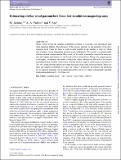Files in this item
Estimating stellar wind parameters from low-resolution magnetograms
Item metadata
| dc.contributor.author | Jardine, Moira | |
| dc.contributor.author | Vidotto, Aline | |
| dc.contributor.author | See, Victor | |
| dc.date.accessioned | 2016-11-15T17:30:16Z | |
| dc.date.available | 2016-11-15T17:30:16Z | |
| dc.date.issued | 2017-02-11 | |
| dc.identifier | 247676705 | |
| dc.identifier | 89dee927-7334-4b1a-85e1-d3e6a7f34287 | |
| dc.identifier | 85019589914 | |
| dc.identifier | 000403083900006 | |
| dc.identifier.citation | Jardine , M , Vidotto , A & See , V 2017 , ' Estimating stellar wind parameters from low-resolution magnetograms ' , Monthly Notices of the Royal Astronomical Society: Letters , vol. 465 , no. 1 , pp. L25-L29 . https://doi.org/10.1093/mnrasl/slw206 | en |
| dc.identifier.issn | 1745-3925 | |
| dc.identifier.other | BibCode: 2016arXiv161103422J | |
| dc.identifier.other | ORCID: /0000-0002-1466-5236/work/57821809 | |
| dc.identifier.uri | https://hdl.handle.net/10023/9824 | |
| dc.description | Funding: UK Science and Technology Facilities Funding Council (STFC). | en |
| dc.description.abstract | Stellar winds govern the angular momentum evolution of solar-like stars throughout their main-sequence lifetime. The efficiency of this process depends on the geometry of the star's magnetic field. There has been a rapid increase recently in the number of stars for which this geometry can be determined through spectropolarimetry. We present a computationally efficient method to determine the 3D geometry of the stellar wind and to estimate the mass-loss rate and angular momentum loss rate based on these observations. Using solar magnetograms as examples, we quantify the extent to which the values obtained are affected by the limited spatial resolution of stellar observations. We find that for a typical stellar surface resolution of 20o–30o, predicted wind speeds are within 5 per cent of the value at full resolution. Mass-loss rates and angular momentum loss rates are within 5–20 per cent. In contrast, the predicted X-ray emission measures can be underestimated by one-to-two orders of magnitude, and their rotational modulations by 10–20 per cent. | |
| dc.format.extent | 1961161 | |
| dc.language.iso | eng | |
| dc.relation.ispartof | Monthly Notices of the Royal Astronomical Society: Letters | en |
| dc.subject | Magnetic fields | en |
| dc.subject | Stars: coronae | en |
| dc.subject | Stars: winds, outflow | en |
| dc.subject | QB Astronomy | en |
| dc.subject | QC Physics | en |
| dc.subject | NDAS | en |
| dc.subject.lcc | QB | en |
| dc.subject.lcc | QC | en |
| dc.title | Estimating stellar wind parameters from low-resolution magnetograms | en |
| dc.type | Journal article | en |
| dc.contributor.sponsor | Science & Technology Facilities Council | en |
| dc.contributor.institution | University of St Andrews. School of Physics and Astronomy | en |
| dc.identifier.doi | 10.1093/mnrasl/slw206 | |
| dc.description.status | Peer reviewed | en |
| dc.identifier.url | http://adsabs.harvard.edu/abs/2016arXiv161103422J | en |
| dc.identifier.grantnumber | ST/M001296/1 | en |
This item appears in the following Collection(s)
Items in the St Andrews Research Repository are protected by copyright, with all rights reserved, unless otherwise indicated.

